Katrina Kenison's Blog, page 4
January 14, 2018
reason to hope
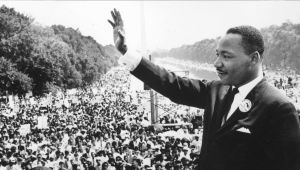 “I have decided to stick to love. . . Hate is too great a burden to bear.” ~ Rev. Martin Luther King
“I have decided to stick to love. . . Hate is too great a burden to bear.” ~ Rev. Martin Luther King
There’s a neighbor up the road I’ve never met. I know his pick-up truck though, as I often find myself driving behind him as we come and go on our daily rounds. The truck is lifted, painted with camo, and festooned with decals and bumper stickers supporting the flag, the military, and the NRA. There’s one that defines gun control as “hitting your target.”
When I’m behind this man, I ease my foot off the gas and slow down, giving him space to roar off up the road and out of sight. Nevertheless, I’ve had ample opportunity over the years to absorb the slogans and messages plastered all over his vehicle, including this one on the center of his tailgate: “If you don’t like it here, you can go back to the shit-hole you came from.”
My heart clenches when I see those words. The angry bigotry, rooted in fear of the “other,” scares and saddens me. I’d never heard someone refer to another country as a shit-hole until I saw my neighbor’s bumper sticker. I wouldn’t recognize the man behind the wheel if we met in line at Rite-Aid, and so I’ve been left to wonder: Who would think, let alone say, something so hateful? Now, of course, I know the answer to that question. We all do.
It is January, 2018, and we live in a country where evening newscasters feel obliged to warn parents that they may want to remove their children from the room rather than expose them to the vile, racist language used by the President of the United States.
There was so much that was so horrifying about the first year of the Trump administration that I slipped, as the months went by, into a habit of trying to protect myself from future shock and more despair by following the issues carefully and then envisioning all the possible worst-case scenarios. There’s plenty of dark fuel for those fires in the daily news from Washington.
But after twelve months, I’m exhausted from being constantly upset. A friend said she’d heard the phrase “outrage fatigue” on the radio this morning and realized that’s exactly what she’s been feeling. Me too. As I thought on New Year’s Day about my intentions for the year ahead, it dawned on me that while there is much going on I can’t control or make sense of, I can choose how to respond. And anger, fear, and despair won’t make the world a better place. Faith might, though; and so could hope. Combine faith and hope with positive actions, no matter how small, and you have a potent alchemy for change.
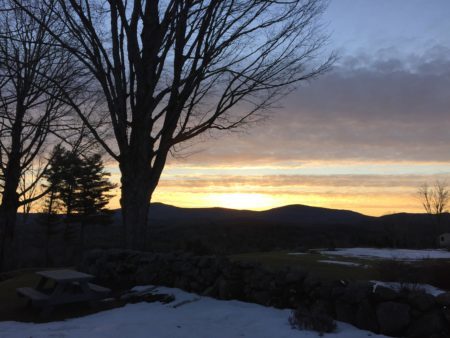 On the first day of this new year, I made myself a promise. Going forward, I would be more mindful of what kind of energy I send out into the world. For me, this means taking a moment early each morning to set the compass of my own heart toward gratitude. It means placing my feet firmly down upon the small, barely discernable path of optimism. It means remembering, as Jesuit priest and author Gregory J. Boyle has written, “There is no force in the world better able to alter anything from its course than love.”
On the first day of this new year, I made myself a promise. Going forward, I would be more mindful of what kind of energy I send out into the world. For me, this means taking a moment early each morning to set the compass of my own heart toward gratitude. It means placing my feet firmly down upon the small, barely discernable path of optimism. It means remembering, as Jesuit priest and author Gregory J. Boyle has written, “There is no force in the world better able to alter anything from its course than love.”
Choosing optimism doesn’t mean turning away from the truth of where we are. It doesn’t mean being in denial about the dangers and the inestimable damage already wreaked by Donald Trump and those who enable him. The reality of this presidency is deeply disturbing. It’s the hateful bumper sticker magnified, touted on television, and turned into policies founded on the notion that some lives matter more than other lives.
But there is another reality. And that is our own humble, human goodness. In his New Year’s Eve message to the people of Rome, Pope Francis expressed his gratitude to the ordinary men and women who quietly contribute to the health and beauty and charm of their city. “Artisans of the common good,” he called them, citizens who simply do what they can to make things better, not through noisy words but by silent deeds.
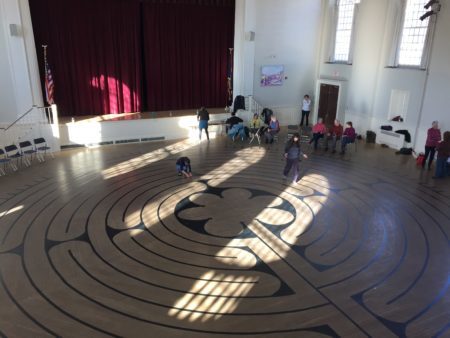 In my own small New Hampshire town, there are artisans of the common good at every turn – grocery boys who carry bags out to cars without being asked, auto mechanics who run a quick vacuum over sand-encrusted floor mats after doing an oil change, neighbors who show up unasked to shovel snow, postmen who deliver mail right to the door on a stormy day. There are singers and actors, artists and writers, activists and speakers who enrich our lives with their creative efforts. There are dedicated volunteers who turn out day after day and year after year, in all kinds of weather, to plant window boxes and town gardens, who teach schoolchildren how to grow and cook healthy food, who manage a vibrant, welcoming food pantry, who carry on traditions such as Children in the Arts Day in the spring, and Peak Into Peterborough in the fall, and the New Year’s Labyrinth.
In my own small New Hampshire town, there are artisans of the common good at every turn – grocery boys who carry bags out to cars without being asked, auto mechanics who run a quick vacuum over sand-encrusted floor mats after doing an oil change, neighbors who show up unasked to shovel snow, postmen who deliver mail right to the door on a stormy day. There are singers and actors, artists and writers, activists and speakers who enrich our lives with their creative efforts. There are dedicated volunteers who turn out day after day and year after year, in all kinds of weather, to plant window boxes and town gardens, who teach schoolchildren how to grow and cook healthy food, who manage a vibrant, welcoming food pantry, who carry on traditions such as Children in the Arts Day in the spring, and Peak Into Peterborough in the fall, and the New Year’s Labyrinth.
There are groups of committed men and women who came together in the wake of the 2016 election and who continue to make phone calls, write letters, and stand strong against the erosion of our democracy and core values. There is the Arab-American who offered a series of evening talks at area libraries last winter entitled “Ask a Muslim Anything,” during which he generously answered any and all questions about Islam and the Muslim faith. And there are the Unitarians who, after a “Black Lives Matter” sign was stolen twice from the lawn in front of the church, made a new banner, a bigger one, and hung it from a second-floor window, out of harm’s way.
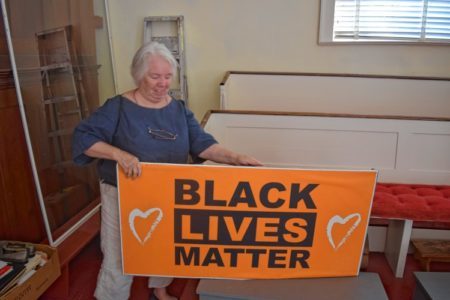 It’s easy, as a white person in a rural, protected community, to take what I have for granted, even as I stare at the ceiling in the dark of night trying to imagine what it must feel like to be one of those 700,000 undocumented kids who were promised a secure life in this country, only to now face threats of being pushed out of the only home they’ve ever known.
It’s easy, as a white person in a rural, protected community, to take what I have for granted, even as I stare at the ceiling in the dark of night trying to imagine what it must feel like to be one of those 700,000 undocumented kids who were promised a secure life in this country, only to now face threats of being pushed out of the only home they’ve ever known.
Nothing I’ve experienced in my own 59 years is akin to that kind of danger and uncertainty. But I am trying to envision myself there, in the shoes of a young immigrant wondering what the future will hold, whether my country will honor its promise, and whether the artisans of the common good will prove stronger in the end than those who seek to expel and to exclude, who wish to build barriers and to separate us from each other.
Tomorrow is Martin Luther King Day. And so this afternoon, writing these words, I go in search of some of his. “Darkness cannot drive out darkness,” King assures us. “Only light can do that. Hate cannot drive out hate: only love can do that.”
This is the encouragement I need right now. Perhaps you need it, too – the reminder that we can only begin to change the world by first changing how we see and respond to the world.
“Faith,” Dr. King said, “is taking the first step even when you can’t see the whole staircase.” Let us celebrate Martin Luther King Day 2018 by heeding his fierce encouragement to keep moving in the direction we want to go. Let us take the first step toward hope, whatever that looks like in this moment. And let us walk arm in arm on this path that was carved out by the words and deeds of all those who traveled it before us, who spoke up for justice, who acted from a place of deep compassion and kinship, and who made of their own ordinary lives a blessing. To be an artisan of the common good is to believe not only in our own goodness, but to shine a light on the goodness of someone else. It is to stand, as Gregory Boyle urges, “with the demonized so that the demonizing will stop.”
Need reason to hope?
Watch this.
Listen to this.
Play this.
Read this.
Check out this.
The post reason to hope appeared first on Katrina Kenison.
December 15, 2017
spicy holiday granola
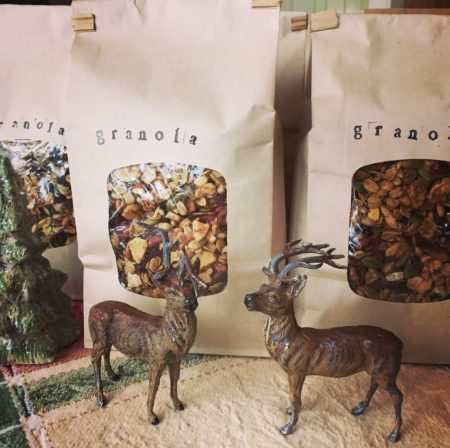 Be attentive lest you miss the grace that passes before you, whether as small as a single birdsong or as broad as the rising sun of your own life restored. Be grateful, lest these pearls have been thrown to swine. And be ready to speak of it in the grandest or simplest words or deeds. You have not invented your own hope; it has sprung, green and living, from the grace that has rained upon you, has welled up from deepest springs, has come to you in steadfast rivers.
Be attentive lest you miss the grace that passes before you, whether as small as a single birdsong or as broad as the rising sun of your own life restored. Be grateful, lest these pearls have been thrown to swine. And be ready to speak of it in the grandest or simplest words or deeds. You have not invented your own hope; it has sprung, green and living, from the grace that has rained upon you, has welled up from deepest springs, has come to you in steadfast rivers.
~ Steve Garnaas-Holmes
The winter sun is pouring through the kitchen windows as I type these words. The temperature outside hovers around 20 degrees, as warm as it will get today. With six inches of powdery snow on the ground, the world looks frosted, ready for Christmas. I’m trying to ready my spirit, too.
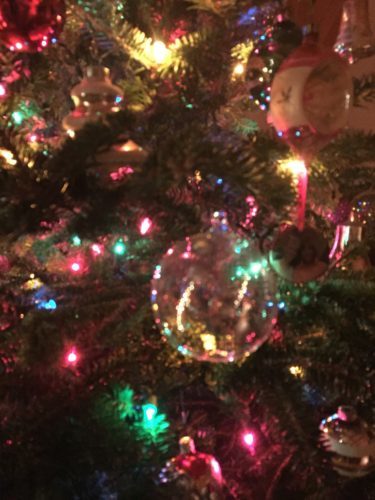 All month I’ve been making lists, crossing things off lists, making new lists – grocery lists, to-do lists, gift lists. Somehow the act of writing things down and crossing them out calms me, as if each small accomplishment or task completed brings me closer to. . .what exactly? The finish line?
All month I’ve been making lists, crossing things off lists, making new lists – grocery lists, to-do lists, gift lists. Somehow the act of writing things down and crossing them out calms me, as if each small accomplishment or task completed brings me closer to. . .what exactly? The finish line?
Of course, the idea of completion is an illusion. There will be to-dos until the day when there aren’t, and I’m certainly not in any hurry to get there. Nor do I want to look at December 25 as the end of some silly holiday race.
So my challenge today, and every day this season, is to simply relax into the day’s doings, whatever they may be. One thing I’ve learned over the years is that the closer I stay to home and hearth during these short, dark days, the more peaceful I feel.
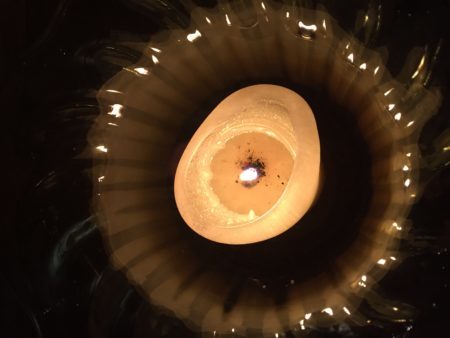 Slowing down, doing less, honoring my own need for quiet, I find there are margins around the to-do lists, room even in a busy day to pause and watch the woodpeckers and juncos at the bird feeder, to bundle up for a walk with my son Henry, home from school this month, or to read a chapter or two of Jack Kornfield’s A Path With Heart, a classic that’s gently, wisely guiding me back to myself and to the precious people whose presence I treasure most. It’s a time to light candles at the dinner table, to sit in a darkened living room with the Christmas tree before turning off lights and heading to bed, to rise early enough to bear witness to the sunrise.
Slowing down, doing less, honoring my own need for quiet, I find there are margins around the to-do lists, room even in a busy day to pause and watch the woodpeckers and juncos at the bird feeder, to bundle up for a walk with my son Henry, home from school this month, or to read a chapter or two of Jack Kornfield’s A Path With Heart, a classic that’s gently, wisely guiding me back to myself and to the precious people whose presence I treasure most. It’s a time to light candles at the dinner table, to sit in a darkened living room with the Christmas tree before turning off lights and heading to bed, to rise early enough to bear witness to the sunrise.
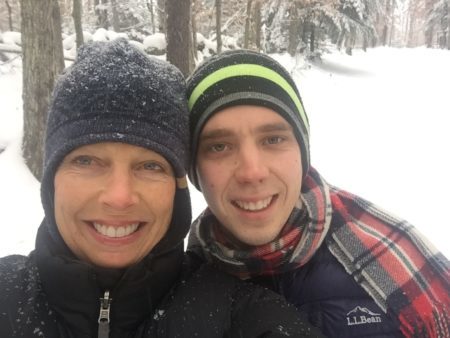 There’s definitely been a shift in my gift-giving this year, fewer store-bought gifts and more donations made in honor of loved ones, more hand-made items that are crafted and sold locally, and more offerings from my kitchen.
There’s definitely been a shift in my gift-giving this year, fewer store-bought gifts and more donations made in honor of loved ones, more hand-made items that are crafted and sold locally, and more offerings from my kitchen.
I’ve shared a few of my favorite holiday recipes here before. But while my mom’s cranberry orange bread is a classic that need not be messed with, my annual granola is always a work in progress. This year’s batch, moistened with olive oil, sweetened with maple syrup, and spiced with cardamom, is a keeper: richly flavored, not too sweet, rather addictive. (Made without butter, it’s also vegan.)
I mailed off quite a few packages yesterday, which means I can linger here this morning on my kitchen stool, gazing out at the snow.
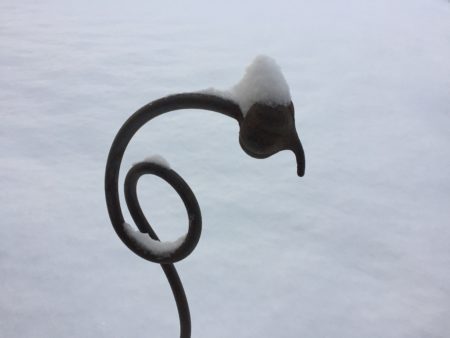 And now that I’ve crossed the post office off my list, I can also type up the tweaked (and somewhat approximate) recipe for you. Although I sometimes give homemade granola in beautiful, re-usable Weck jars, this year I ordered simple brown bags and hand-stamped them: fun, easy, and charming. You can get the bags I used here, the stamps and ink here and here. I always keep a box of this parchment on hand, not only for granola but also for cookies, roasted vegetables, toasting nuts, and just about anything that goes on a cookie sheet.
And now that I’ve crossed the post office off my list, I can also type up the tweaked (and somewhat approximate) recipe for you. Although I sometimes give homemade granola in beautiful, re-usable Weck jars, this year I ordered simple brown bags and hand-stamped them: fun, easy, and charming. You can get the bags I used here, the stamps and ink here and here. I always keep a box of this parchment on hand, not only for granola but also for cookies, roasted vegetables, toasting nuts, and just about anything that goes on a cookie sheet.
The Buddhists have a saying: “You can never enter the same river twice.” By the same token, I’d propose, “You can never make the same granola recipe twice.” The beauty of homemade granola is that you’ll soon be playing around with all sorts of flavor combinations. Use the nuts and seeds that appeal to you. Cut back on the brown sugar for a more savory granola, or add melted butter for a toastier crunch. A middle eastern combo might include pistachios, with chopped apricots and dried rose petals tossed in after baking; a New England flavor is achieved with dried cranberries and dried blueberries. I’ve made versions using various combinations of grated orange zest, chia seeds, sesame seeds, hemp hearts, coconut flakes, cinnamon chips, dried banana slices, cacao powder, lavender buds, wheat germ, flax seeds, oat bran, honey instead of maple syrup, coconut oil instead of olive oil, even a few grinds of black pepper. Experiment, keep the flavors simple and complementary, take notes, and let your taste buds and imagination be your guide. (Note: items above are affiliate links.)
Happy baking, and may your holidays be warm and bright!
Maple Olive Oil Cardamom Granola
9 cups old-fashioned rolled oats
2 cups raw pumpkin seeds
2 cups raw sunflower seeds
2 cups walnuts
2 cups sliced or slivered almonds
2 cups pecans
1 ½ cups grade B maple syrup
2 cups extra virgin olive oil
1 cup dark brown sugar
1 T. vanilla
Maldon’s salt flakes or coarse sea salt to taste
1 T. cinnamon
1 T. cardamom
6 cups of mixed dried fruits – this year I used golden raisins, cherries, and cranberries.
¾ C. minced crystallized ginger.
Heat oven to 300° F.
Place oats, nuts and seeds, syrup, olive oil, sugar, spices, and 4 teaspoons salt (more or less according to preference) in a large bowl and mix until well combined. Taste-test for spiciness and add more if granola seems too bland. Spread granola mixture in an even layer (not too heavily — give it room!) on 3 rimmed baking sheets lined with parchment. Transfer to oven and bake, stirring and rotating pans every 10 to 15 minutes, until granola is toasted, about 45 minutes.
Remove granola from oven, pour into a large bowl, and season with more salt to taste. Stir in the dried fruits and the ginger. Reuse the parchment paper for the next batch. Let granola cool completely before serving, packing in gift bags, or storing in an airtight container for up to 1 month. Granola freezes beautifully in zip-lock plastic bags.
books for giving–there’s still time
I’ve heard from quite a few readers who plan to give copies of Moments of Seeing this season. That means so much to me, and I’d love to make it even easier for you. For the month of December only, I’m offering signed copies of Moments of Seeing for just $15, a savings of 25% off the list price of $20. Buy four copies (or any combination of my books totaling $60) and your shipping is free. I’ll tuck in a bookmark, too!
Click here to order.
The link takes you to my husband Steve’s small company, Earth, Sky & Water, where you may well be tempted to do some other holiday shopping. I especially love the new holiday themed notecards and keep asking him to bring more of them home for me. Perfect stocking stuffers and hostess gifts.
The post spicy holiday granola appeared first on Katrina Kenison.
December 5, 2017
choosing joy
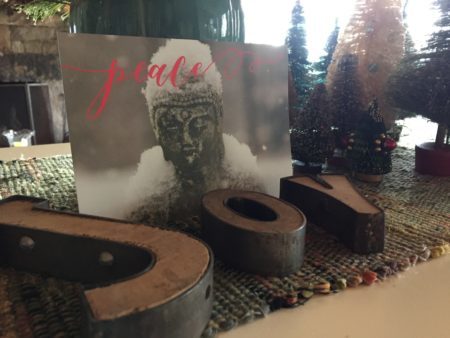 I’ve spent the last few weeks rummaging around in the basement, carting boxes of stuff off to Goodwill, decorating for the holidays, making granola and other gifts from the kitchen. When my mind is unsettled, I have a hard time sitting still. Better to put my body to work doing something physical that manifests visible results, whether it’s baking cookies or cleaning the shower drain (I did that this morning).
I’ve spent the last few weeks rummaging around in the basement, carting boxes of stuff off to Goodwill, decorating for the holidays, making granola and other gifts from the kitchen. When my mind is unsettled, I have a hard time sitting still. Better to put my body to work doing something physical that manifests visible results, whether it’s baking cookies or cleaning the shower drain (I did that this morning).
Still, it feels strange to be entering the holiday season, stringing lights and cutting greens, when there’s so little cause for celebration in the world at large and when so much of what we hold sacred (truth, democracy, and decency for starters) is under full-scale assault. To pay close attention to what’s happening in our country is to wrestle with painful realities most of us couldn’t have begun to imagine even a year ago. It is to open, as Annie Proulx recently observed, “a savagely difficult book without a happy ending.”
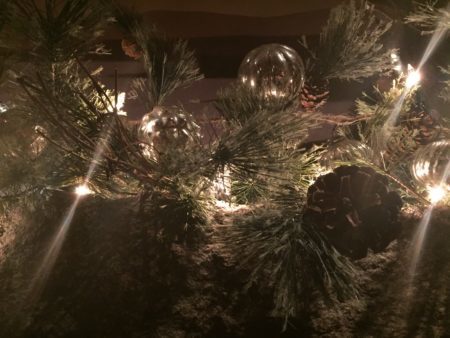 And yet, it is December, time in our house to put up a tree, to welcome grown children home, to bake cranberry bread and wrap gifts and gather with friends and family. What I always love most about these weeks before Christmas is the opportunity to connect with loved ones near and far, sending packages off in the mail, exchanging cards and holiday letters, lighting candles and gathering around crowded dinner tables. But this year feels different, as if the darkness of our human affairs has dimmed the lights of hope and faith and joy.
And yet, it is December, time in our house to put up a tree, to welcome grown children home, to bake cranberry bread and wrap gifts and gather with friends and family. What I always love most about these weeks before Christmas is the opportunity to connect with loved ones near and far, sending packages off in the mail, exchanging cards and holiday letters, lighting candles and gathering around crowded dinner tables. But this year feels different, as if the darkness of our human affairs has dimmed the lights of hope and faith and joy.
My guess is I’m not alone in feeling shaky and overwhelmed. Yesterday after yoga class, my friend Maude and I paused in front of a plaque in the studio, a quote from the Dalai Lama. Although I’ve walked straight past these words on the wall a hundred times, they suddenly hit home with the force of truth: “There are only two days in the year that nothing can be done. One is called Yesterday and the other is called Tomorrow. Today is the right day to Love, Believe, Do, and mostly live.”
I have been desperately in need of this reminder. There’s no magic formula that can take us back to better times. No amount of worry or despair or sleepless nights will shape our future. But there is today. And today offers countless opportunities to act with kindness, to embody peace, to donate to a good cause, to call a friend (or a politician!), to visit someone who’s alone, to take small steps toward the light, steps that make the world just a little bit better.
Perhaps this is the challenge we are called to this season: to choose joy without turning a blind eye to the chaos. Joy not as an emotional response to the outer world, but joy as a practice, joy as an inner vibration of the soul, joy as an offering, a way of being, a way of healing what is broken.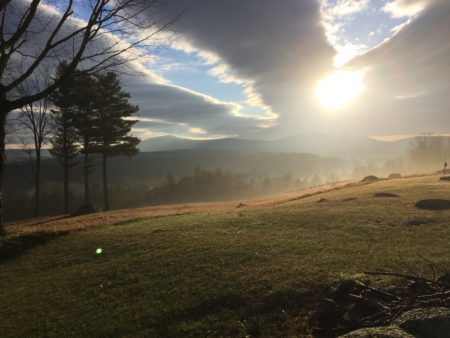
Do not be dismayed by the brokenness of the world.
All things break. And all things can be mended.
Not with time, as they say, but with intention.
So go. Love intentionally, extravagantly, unconditionally.
The broken world waits in darkness for the light that is you.
~ L. R. Knost
books for holiday giving
I’ve heard from quite a few readers who plan to give copies of Moments of Seeing this season. That means so much to me, and I’d love to make it even easier for you. For the month of December only, I’m offering signed copies of Moments of Seeing for just $15, a savings of 25% off the list price of $20. Buy four copies (or any combination of my books totaling $60) and your shipping is free. I’ll tuck in a bookmark, too!
Click here to order.
The link takes you to my husband Steve’s small company, Earth, Sky & Water, where you may well be tempted to do some other holiday shopping. I especially love the new holiday themed notecards and keep asking him to bring more of them home for me. Perfect stocking stuffers and hostess gifts.
The post choosing joy appeared first on Katrina Kenison.
November 8, 2017
a blessing for deeper knowing
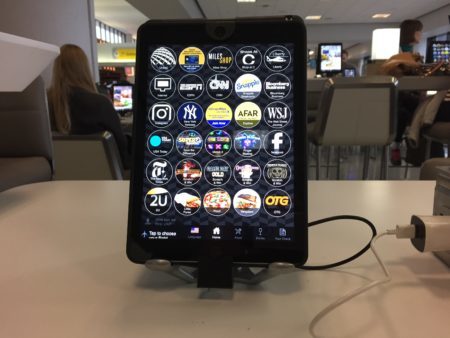 “In a real sense all life is interrelated. All persons are caught in an inescapable network of mutuality, tied in a single garment of destiny. Whatever affects one directly affects all indirectly. I can never be what I ought to be until you are what you ought to be, and you can never be what you ought to be until I am what I ought to be. This is the inter-related structure of reality.” ~ Rev. Martin Luther King
“In a real sense all life is interrelated. All persons are caught in an inescapable network of mutuality, tied in a single garment of destiny. Whatever affects one directly affects all indirectly. I can never be what I ought to be until you are what you ought to be, and you can never be what you ought to be until I am what I ought to be. This is the inter-related structure of reality.” ~ Rev. Martin Luther King
I spent a good part of Sunday flying from New Hampshire to Asheville, North Carolina, to visit my younger son Jack. I love this kind of low-stress travel day, especially when what’s waiting at the end of the journey is not a professional obligation, but simply a change of scene and a son to wrap my arms around.
En route, I buried myself in a book. But a lay-over in Newark gave me an opportunity for people watching. It’s been a while since I passed through a state-of-the-art airport, so I was unnerved to see electronic tablets attached to the top of every flat surface. The restaurant tables all feature a pair of devices set up back to back, so that people sitting across from one another will find themselves gazing at hi-def photos rather than into each other’s eyes. Any hope of leaning in and conversing with a friend or loved one while sharing a meal is extinguished by an electronic barrier of flashing pixels.
I stood for a while at one cafe where adults and children alike were intently focused on the technology, heads bent, leaning toward their personal screens as if magnetized. Couples and families occupying the same tables were clearly inhabiting different online universes. Everyone was staring and tapping and swiping and typing. No one was paying attention to the person across from them. No one was talking. No one seemed to be really “there.”
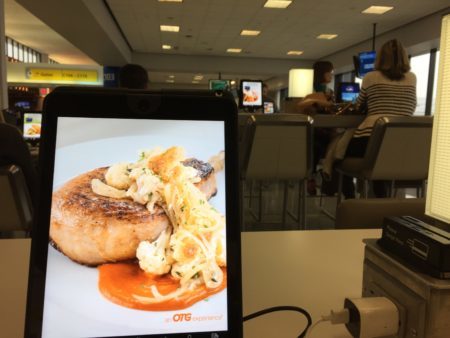 Taking a seat near my gate, I found my own eyeballs inexorably drawn to the bright screen where a fine scotch was being poured over ice. The drink was replaced by a pasta dish puddled in sauce, which made my stomach rumble and which was available packed to-go if I tapped right now and placed my order. The meal gave way to a video of a couple walking hand in hand on a beach I could visit, should I care to make a reservation.
Taking a seat near my gate, I found my own eyeballs inexorably drawn to the bright screen where a fine scotch was being poured over ice. The drink was replaced by a pasta dish puddled in sauce, which made my stomach rumble and which was available packed to-go if I tapped right now and placed my order. The meal gave way to a video of a couple walking hand in hand on a beach I could visit, should I care to make a reservation.
A time traveler from the last years of the twentieth century changing planes in Newark might look around at how we’re living right now, in the early years of the twenty-first, and conclude that human beings no longer have much use for, or interest in, one another. She might assume that we must now need to be attached to machines in order to function, and that our 2017 brains must be wired differently from those of our grandparents. To some extent, the time traveler would be right. And perhaps, after observing for a while, the disoriented twentieth-century pilgrim would find her initial astonishment giving way to musings more akin to my own — a hard-to-articulate sense that something essential to our survival is being lost, something having to do with soul and depth and knowing.
 Last week I posted a link on Facebook to an essay entitled America is Facing an Epistemic Crisis. I’d initially been drawn to the piece because I wasn’t sure of the meaning of the word “epistemic.” I looked it up: of or relating to knowledge or the conditions for acquiring it.
Last week I posted a link on Facebook to an essay entitled America is Facing an Epistemic Crisis. I’d initially been drawn to the piece because I wasn’t sure of the meaning of the word “epistemic.” I looked it up: of or relating to knowledge or the conditions for acquiring it.
My interest was piqued. The essay, which was provocative and disturbing, includes this observation:
The US is experiencing a deep epistemic breach, a split not just in what we value or want, but in who we trust, how we come to know things, and what we believe we know — what we believe exists, is true, has happened and is happening.
The piece is decidedly political and openly opinionated. And David Roberts’s well-informed opinions give way to speculation: what could happen, given where we stand right now. But Roberts backs up his speculations with the facts that led him down this path in the first place. And he is also getting at something much larger and much scarier: the increasingly limited, tribal, pre-packaged, and non-fact-based way we acquire knowledge in an age when we spend so much of our lives online, clicking and scanning, liking and sharing, tuning out (or not even seeing) the truths that don’t align with our beliefs.
I don’t want to live like that.
And so I’m thinking a lot this week about just what and how I choose to “know” in my own life.
On Facebook a friend commented about the piece I’d shared, saying he was put off by the unfamiliar word in the title, and that upon a quick look he’d concluded the author’s assumptions were misguided. Confronted with the daily tsunami of media that pours through my own computer screen, I often catch myself reading this way, too — scanning headlines while trying to keep my overwhelmed brain above water. It’s tempting to dismiss anything that appears too dense or hard or contradictory, while grabbing onto whatever floats by that supports what I already believe to be true. Perhaps I don’t want to “know” as much as I wish to be updated and validated.
As I type these words, I can hear the sound of rain falling steadily. A breeze wafts through an open window. Other than the hum of the refrigerator and an occasional dog barking outside, it’s quiet here in the airbnb room I’ve rented for the week. I have a pile of books on the table next to me, and a letter part-way written that I want to give to Jack for his birthday. Alone with my thoughts, I have plenty of time to reflect on my own uneasy relationship with technology – how it contributes to my awareness of world events while simultaneously weakening my capacity for the kind of deep reflection and processing I need in order to truly absorb and understand them.
To really know anything – be it another person, a language, a skill, an existential threat, or the contents of our own hearts – demands a kind of patience and raw intimacy with truth that seems antithetical to our culture these days. We are so good at skimming, judging, and distracting ourselves that the complex or uncomfortable truth takes a back seat to our desire for instant gratification, quick fixes, and pain-free solutions. It is easier to react than to reflect, simpler to see in terms of black and white than to acknowledge how much of the world is gray, safer to defend a position than to question it, easier to shut down our thinking than to shift it. And yet, as David Roberts points out in his essay, “Truth cannot speak for itself, like the voice of God from above. It can only speak through human institutions and practices.”
Many of us are profoundly worried about our human institutions at the moment, and it’s hard not to feel helpless in the face of so much that’s so wrong. But it’s also dawning on me that If I’m to “know” anything of real value, I must be even more willing to be quiet and to go deep.
What if true knowing begins the moment we’re ready to acknowledge all that we don’t know?
Knowing deepens every time we step into someone else’s ill-fitting shoes and walk in them. It happens when we recognize the difference between facts and feelings, when we wrestle with real ideas rather than seeking refuge in ideology. To know is both to doubt absolutes and to stand firmly on the side of truth. It is surrender to life as it actually is, even as we step forward to change that which can be be made better. (Witness yesterday’s elections!) Knowing means greeting those who are different with radical compassion and those in need with generosity and friendship. To know is to observe and to wonder, rather than surrendering to easy preconceptions, reductive labels, and media bias. It is to replace pedagogy with curiosity, prejudice with open-mindedness, posturing with humility, habitual distractions with cultivated attentiveness. It is to say, “Maybe I’m wrong about this.” Or, “Tell me what you know.” And then it is to do the hard, necessary work of showing up, digging in, and learning more.
We honor truth in our lives when we invite complexity and discomfort and uncertainty into our conversations and into our relationships. And we begin to know in our bones what is true when we turn away from the glib gratification of the news cycle and the stimulation of our devices, and turn instead back toward each other – in airports, on the street, at our own dinner tables, in works of art and literature.
To know is to listen more and to speak less. It is to release our grip on the need to be right or popular or powerful. It is to question our assumptions, to reject pat answers and political rhetoric and mindless rallying cries. To know requires us to read and think deeply, to write and speak with integrity, to wrestle with complex ideas, and to lift our eyes to the messy, beautiful, big picture that’s the real world, rather than staring down at the tiny one that fits in the palm of our hands.
This work of knowing begins anew each day, with our own quiet recommitment to truth in all its painful, beautiful, and confusing complexity. And truth, of course, begins with me: the truth of who I really am, the truth of what I say and do, the truth of the consequences of every choice I make. So it is for each of us.
The world we live in today is a world we have created together – a world of post-facts, cynicism, distrust, and deep division; of amoral politicians, well-paid lobbyists, and corporations masquerading as citizens; of Facebook, Twitter, Breitbart, and Fox; of a dangerous president propped up by big-money politics, brutality and bigotry; of climate change and mass shootings and saber-rattling threats of nuclear war. It seems as if we have built this world while in the grip of some terrible trance, a collective amnesia that denies our own deepest knowing: namely, that we are all connected, not by algorithms but by grace, and that my survival depends on yours.
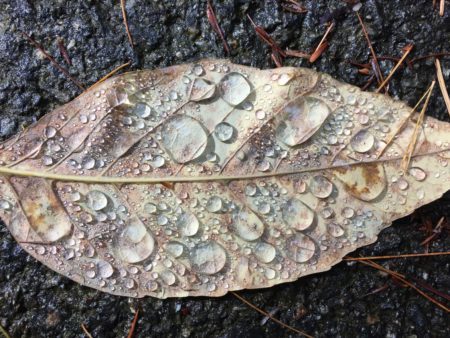 And yet there is also a kind of knowing that surely does still reside somewhere in each of us, if we can be quiet and tender enough to call it forth. Walking through the autumn woods yesterday with Jack and his dog, reaching toward the sky in yoga class this morning, chatting on the phone with my husband, splashing through puddles on my way back to this room, I found my heart uplifted in spite of everything that conspires to bring it down. There is such mystery and joy in the moments when we are fully and gratefully present in our lovely, precious, embattled world.
And yet there is also a kind of knowing that surely does still reside somewhere in each of us, if we can be quiet and tender enough to call it forth. Walking through the autumn woods yesterday with Jack and his dog, reaching toward the sky in yoga class this morning, chatting on the phone with my husband, splashing through puddles on my way back to this room, I found my heart uplifted in spite of everything that conspires to bring it down. There is such mystery and joy in the moments when we are fully and gratefully present in our lovely, precious, embattled world.
Perhaps it was not happenstance but synchronicity that led me to these lines by theologian Richard Rohr early this morning as I lay in bed reading and listening to the rain on the roof.
If you asked me what it is I know, I would be hard pressed to tell you. All I know is that there is a deep “okayness” to life—despite all the contradictions—which has become even more evident in the silence. Even when much is terrible, seemingly contradictory, unjust, and inconsistent, somehow sadness and joy are able to coexist at the same time. The negative value of things no longer cancels out the positive, nor does the positive deny the negative.
Whatever your personal calling or your delivery system for the world, it must proceed from a foundational “yes” to life. Your necessary “no” to injustice and all forms of un-love will actually become even clearer and more urgent in the silence, but now your work has a chance of being pure healing instead of impure anger and agenda.
Our future depends upon our commitment to a deeper kind of knowing, on our ability to connect, reflect, and take informed action. To know is not just a choice we make, but a responsibility we bear together. Whether we’ll survive these dark times is anybody’s guess, but I’m pretty certain our best hope of saving our world is to engage with it, to know it more intimately, to accept the challenge of healing it together, not out of anger but with love.
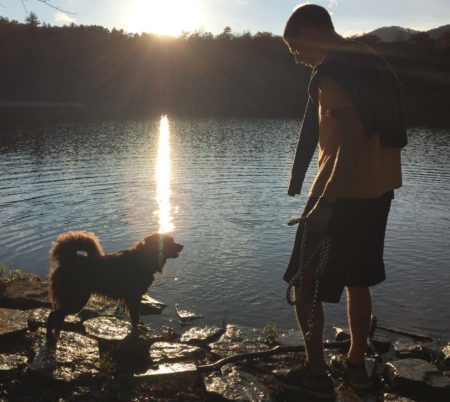 A Blessing for Deeper Knowing
A Blessing for Deeper Knowing
May we take time each day to close down our screens, turn off the TV, and seek to know with our eyes, our ears, our hearts. May we study the lessons of history so that we don’t repeat them. May we read works that challenge our beliefs and open our eyes and remove the barriers between us. May we recite poetry out loud. May we lean in for the hard conversation, take up the good cause, write the check, compose the letter, make the phone call. May we show up with our voices and our feet and our dollars. May we reach out a hand to a stranger, reweave a connection with a friend, go deep into uncharted territory with a loved one. May we set down the burdens of hatred and judgment and fear. May we view all life as sacred. May we listen to magnificent music and visit great paintings, climb mountains and walk barefoot at the shore. May we remember to contemplate the sky, the stars, the dawn. May we nourish our souls with silence and renew our love affair with the earth. May we tend to the children and plants and animals within our reach. May we feed the hungry, care for those in need, and celebrate those who serve. May we transcend our differences. May we tap into our own deep knowing and use it for the good of all. And may we continue to be sources of healing and instruments of peace for as long as we are here. May we raise up hopeful voices in a resounding, knowing “yes” to life.
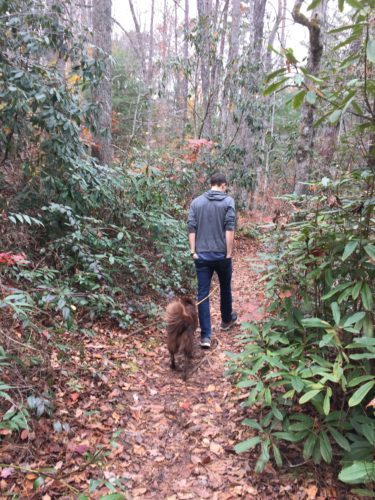
The post a blessing for deeper knowing appeared first on Katrina Kenison.
October 11, 2017
making room
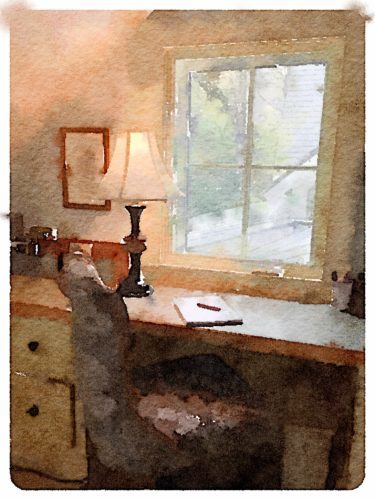
A few weeks ago I phoned my son Jack in Asheville. “How would you feel about me taking over your bedroom at home and turning it into a writing space?” I asked.
I’d hesitated for weeks before raising this idea. But Jack didn’t hesitate in his response. “Oh, that’s fine,” he said, “you can do whatever you want with my room.”
Although we have a tiny office on the first floor of our house, I’ve never written a word in it. The desktop computer is my husband’s and his in-box sits beside it, overflowing with not-urgent papers and clippings and instruction manuals. The window above the desk looks out to the driveway and whatever vehicles happen to be parked there. The counter is a repository for checkbooks and bills to be paid, stamps and envelopes. And the chair, just the right height for Steve, is not very inviting to me. The office is a perfectly good place to write a check or Google driving directions, but it’s not a space my muse has ever chosen to visit.
Most of the words I’ve produced over the last ten years in this house have come from a stool at the kitchen table, where I look out to a view of fields and mountains and sky. I’ve spent countless hours perched there, staring out the windows above the sink while trying to pull my thoughts together. As a mother, as a wife, as a cook and homemaker, and also as a writer, I’ve always been drawn to this room, my own home base, whether I’m chopping something, stirring something, washing something, or writing something. Soups and emails, jars of jam and blog posts, thank you notes and books, all have come from my kitchen. More often than not, several of these things are coming together at once, which means that the written work can easily be shifted to the bottom of my priorities list. No one actually cares if I write or not, but dinner does have to appear on that table every night.
And yet, as summer turned to fall this year, I found myself longing for some other kind of place, a place not in the middle of the action but away from it. A place in which some new work might begin to take shape, privately and quietly. A place where there is nothing that needs to be chopped or watered or cleaned or stirred, where books of memoir and poetry would be easily at hand, and where my laptop and notes and papers don’t have to be put away at the end of the day so that placemats and napkins and silverware can be laid out in their place.
I wasn’t sure, after Magical Journey was published five years ago, whether I would ever write another book. I’m still not sure. But I do know this: turning fifty-nine last week has given me pause. In a year, I’ll be sixty, and there are some things in my life that need to shift, some thinking and writing I very much want to do.
My sixtieth year has begun with an urgent longing for quiet time and open-ended hours and, too, for a space that is devoted not to many things but to one thing: the work of the imagination, the murmurings of the soul, the possibility of articulating and embodying some just-forming ideas about how to live in the world as an older person.
Hence, my call to Jack.
“What about all the things in your desk?” I asked him. “I don’t need any of it,” he said.
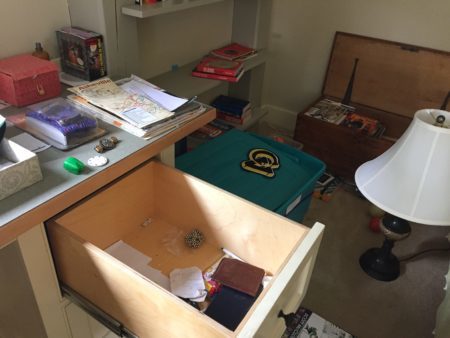 That night, I reported our conversation to Steve, and the next morning he summoned me into Jack’s room. “Tell me what you’re envisioning here,” he said, as we looked around at the olive green walls, the bookshelves packed with Stephen King mysteries and old textbooks, the coin jar on the desk, the squash and basketball trophies dimmed by dust.
That night, I reported our conversation to Steve, and the next morning he summoned me into Jack’s room. “Tell me what you’re envisioning here,” he said, as we looked around at the olive green walls, the bookshelves packed with Stephen King mysteries and old textbooks, the coin jar on the desk, the squash and basketball trophies dimmed by dust.
My birthday gift from my husband was carte blanche to create the space I wanted here. And, in truth, my gift from Jack was exactly the same thing. We called a painter.
And then, on the day I began emptying desk drawers and throwing high school notebooks into a trash bag, I snapped a photo of Jack’s collection of Crazybones (a prized first-grade possession) and called him again. “Is there anything here you want me to save or send down to you?” I asked, fighting back sudden, unexpected tears. He asked me to keep his books, to pack them all into boxes till the day when he has a larger place of his own and room for them. The rest could go.
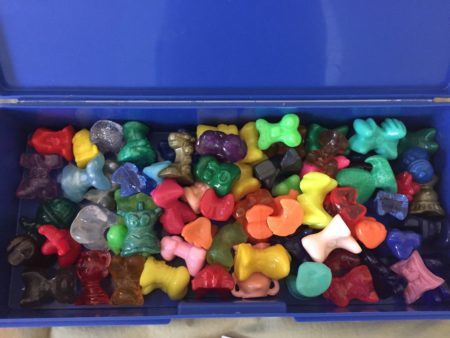 “I’m not attached,” he said simply. “That’s not really my room anymore.”
“I’m not attached,” he said simply. “That’s not really my room anymore.”
What I realized in that moment was that he wasn’t attached, but I was. Taking my son’s bedroom apart and turning it into something else meant I’d no longer peek in on my way past the door and see “him.” Never again would I catch a fleeting sense of his presence there, or see his tiny hippo figurines marching silently across a shelf, or the row of Shel Silverstein books we’d spent so many long-ago hours reading aloud together.
But there’s something else, too. My emotions about dismantling Jack’s bedroom are more complicated than physically acknowledging the end of one chapter and the beginning of another. The truth is, this room was also the setting for some deeply painful struggles, secrets and lies, dashed hopes and heartbreaking realities.
 The happy adolescence we hoped our son would enjoy here never happened. More often than not when he was home, the door to this room was closed. What went on behind that door was the beginning of a downward spiral that, at the time, left us all feeling helpless and angry and frightened. After Jack abruptly left home at sixteen for a stint in wilderness therapy and boarding school, it was all I could do to walk past his empty, silent room. It felt like a rebuke. When we sent our son away for treatment, I wasn’t at all sure whether we’d failed him as parents or helped to save him.
The happy adolescence we hoped our son would enjoy here never happened. More often than not when he was home, the door to this room was closed. What went on behind that door was the beginning of a downward spiral that, at the time, left us all feeling helpless and angry and frightened. After Jack abruptly left home at sixteen for a stint in wilderness therapy and boarding school, it was all I could do to walk past his empty, silent room. It felt like a rebuke. When we sent our son away for treatment, I wasn’t at all sure whether we’d failed him as parents or helped to save him.
The other day, I pulled an old, nearly empty Smart Water bottle out of the back of a desk drawer, tossed it into the trash bag, and then, without even thinking, pulled it out again, unscrewed the cap, and tasted the clear liquid. Vodka. Time collapsed and suddenly I was once again the mother of a silent, distant teenager, finding my way in the darkness with nothing to go on but my own maternal intuition. Yes, this excavation is hard. For a lot of reasons.
Jack has been sober for nearly two years. A month shy of twenty-five, he works in a residential treatment center for troubled adolescents, a job he loves and is good at. He shares a comfortable, homey house with two friends and is a devoted “parent” to his beloved dog Carol. His own rocky path into adulthood has given him deep compassion for the kids he works with, and his own commitment to sobriety has taught him a lot about staying with uncomfortable feelings, accepting them, trusting that they, too, will pass.
And so, I shared with Jack that I was having a harder time cleaning out his old room than I’d expected. He got it.
“I just finished writing a new song,” he told me a few minutes later, after I’d composed myself. “It’s about addiction, and denial, and getting sober. I’m pretty excited about it.” I said I’d love to read the lyrics and he promised to send them. Then, after a pause, he said, “Or, I could just rap it for you right now.” And he did.
 These words are the first to come from my new office on the second floor. The walls are painted a soft shade of blue. There are flowers in a vase, a friend’s drawing on the wall, my own books on the shelves. There’s also a painting Jack did in 8th grade, when he was assigned to copy a work by a master, and some figures he made in grade school that, to me, speak eloquently of the creative, funny, sensitive child he always was and still is at heart. As it turns out, it feels just right to make space here for what has been, for what still is, and for what yet might be.
These words are the first to come from my new office on the second floor. The walls are painted a soft shade of blue. There are flowers in a vase, a friend’s drawing on the wall, my own books on the shelves. There’s also a painting Jack did in 8th grade, when he was assigned to copy a work by a master, and some figures he made in grade school that, to me, speak eloquently of the creative, funny, sensitive child he always was and still is at heart. As it turns out, it feels just right to make space here for what has been, for what still is, and for what yet might be.
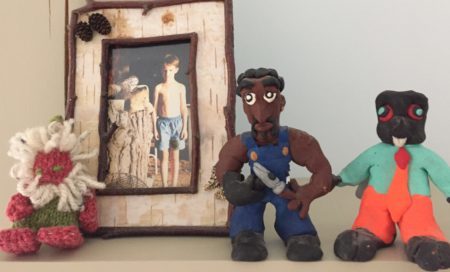 In the kitchen below, I can hear the dishwasher completing its cycle. But I’m not tempted to stop what I’m doing in order to put dishes away, or to wipe crumbs off the counter, or to water the fern. There is nothing to pull me away from where I am. When I look up from this screen, I gaze out the window at the stonewall and trees that Jack would have seen as a teenager, had he lifted the shade in his bedroom. One by one, the leaves drift down.
In the kitchen below, I can hear the dishwasher completing its cycle. But I’m not tempted to stop what I’m doing in order to put dishes away, or to wipe crumbs off the counter, or to water the fern. There is nothing to pull me away from where I am. When I look up from this screen, I gaze out the window at the stonewall and trees that Jack would have seen as a teenager, had he lifted the shade in his bedroom. One by one, the leaves drift down.
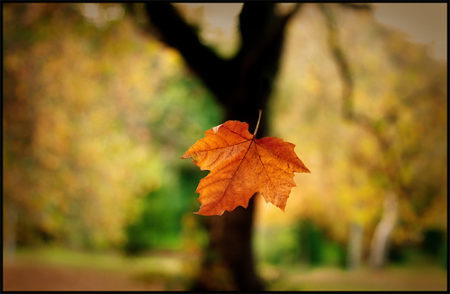 (My gratitude to Jack — for giving me his old room and, even more, for allowing me to publish this essay. One thing we’ve both learned is that every time we tell of our own struggles, we clear a space for someone else to share theirs, too.)
(My gratitude to Jack — for giving me his old room and, even more, for allowing me to publish this essay. One thing we’ve both learned is that every time we tell of our own struggles, we clear a space for someone else to share theirs, too.)
SaveSave
SaveSave
The post making room appeared first on Katrina Kenison.
September 9, 2017
no sides
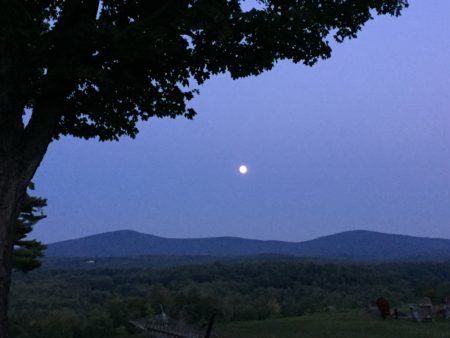 The crickets sang in the grasses. They sang the song of summer’s ending, a sad, monotonous song. “Summer is over and gone,” they sang. “Over and gone, over and gone. Summer is dying, dying.” The crickets felt it was their duty to warn everybody that summertime cannot last forever. Even on the most beautiful days in the whole year — the days when summer is changing into fall — the crickets spread the rumor of sadness and change. ~ E. B. White, Charlotte’s Web
The crickets sang in the grasses. They sang the song of summer’s ending, a sad, monotonous song. “Summer is over and gone,” they sang. “Over and gone, over and gone. Summer is dying, dying.” The crickets felt it was their duty to warn everybody that summertime cannot last forever. Even on the most beautiful days in the whole year — the days when summer is changing into fall — the crickets spread the rumor of sadness and change. ~ E. B. White, Charlotte’s Web
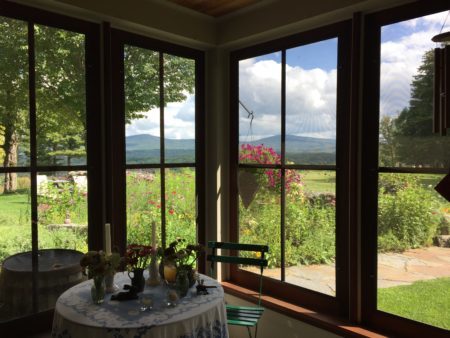 I’ve been listening to the crickets’ warnings all afternoon, trying to accept the truth: summertime cannot last forever. Much as I would love a hundred more days just like this one, there’s no denying that change is in the air. From my “summer office” — an old blue chair on the screened porch — I have a view of mountains, garden, and sky. It’s as serene a vista as any human being could hope to call home. There is not another person in sight and I’ve allowed my computer screen to darken into sleep mode on the table in front of me. And yet distractions are plentiful.
I’ve been listening to the crickets’ warnings all afternoon, trying to accept the truth: summertime cannot last forever. Much as I would love a hundred more days just like this one, there’s no denying that change is in the air. From my “summer office” — an old blue chair on the screened porch — I have a view of mountains, garden, and sky. It’s as serene a vista as any human being could hope to call home. There is not another person in sight and I’ve allowed my computer screen to darken into sleep mode on the table in front of me. And yet distractions are plentiful.
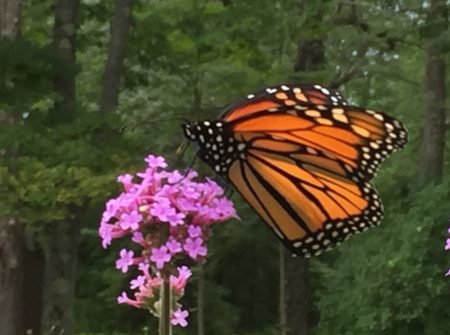 Bright, busy monarchs float from one purple verbena spire to another, and every few minutes I step outside to count them. Six at once today, more than I’ve ever seen here at one time. A pair of bluebirds splash in the birdbath while woodpeckers and jays come and go from the feeder. A breeze rustles through the leaves, clouds slide by, bees hum, the sun slips behind the trees. As the day turns and the shadows lengthen, the cricket song intensifies, as if more and more insect musicians are finding their way into the field, tuning up their instruments, and joining the symphony. It’s hard to get much writing done.
Bright, busy monarchs float from one purple verbena spire to another, and every few minutes I step outside to count them. Six at once today, more than I’ve ever seen here at one time. A pair of bluebirds splash in the birdbath while woodpeckers and jays come and go from the feeder. A breeze rustles through the leaves, clouds slide by, bees hum, the sun slips behind the trees. As the day turns and the shadows lengthen, the cricket song intensifies, as if more and more insect musicians are finding their way into the field, tuning up their instruments, and joining the symphony. It’s hard to get much writing done.
Every year, my family teases me for mourning the end of summer even before the 4th of July fireworks are over. I always want more – more dawn hikes up the mountain, more strawberries and blueberries and peaches to pick, more arugula and basil to cut from the garden, more swims in the pond, more dinners on the porch, more bouquets of cosmos and zinnias, more fires on the hilltop, more s’mores eaten in the dark, more nights of deep sleep with all the windows open.
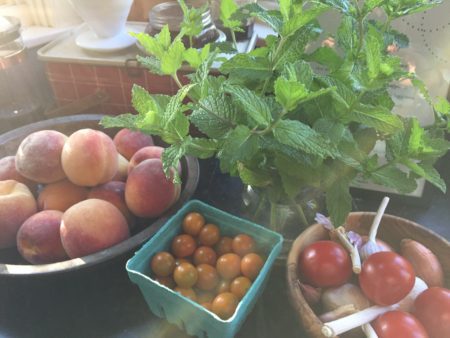 And yet, all summer long we have had these things. We’ve watched magnificent sunrises and sunsets, stood outside before bed gazing up at stars, tracked every phase of the moon as it’s traveled across the sky. There were swims and walks, pies and cobblers and corn, candlelit dinners and countless bouquets. This year in the garden, my cosmos reseeded, poppy seeds scattered without much thought last fall produced a lavish display of lavender blooms all through July, marigolds thrived, and rain fell often.
And yet, all summer long we have had these things. We’ve watched magnificent sunrises and sunsets, stood outside before bed gazing up at stars, tracked every phase of the moon as it’s traveled across the sky. There were swims and walks, pies and cobblers and corn, candlelit dinners and countless bouquets. This year in the garden, my cosmos reseeded, poppy seeds scattered without much thought last fall produced a lavish display of lavender blooms all through July, marigolds thrived, and rain fell often.
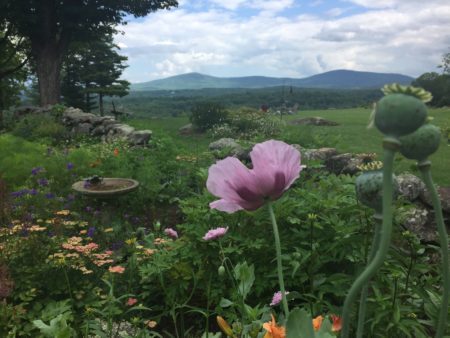 Our soul daughter Lauren came north to Boston for work and added in New Hampshire visits every time. Henry was home for a month before leaving for grad school in Cincinnati, and we drove to Maine for a perfect lobster roll and a walk by the ocean. Although Jack couldn’t get here, the rest of us gathered for a raucous, wonderful family dinner in my parents’ house on Bailey Island — a place so full of memories that to be there on a summer eve is to feel time collapse in upon itself, past, present and future colliding into one visceral breath of familiarity and longing and love. Here at home we have lingered around bonfires and roasted marshmallows and sent wish lanterns aloft, fueled by flames and silently bearing our hopes and dreams for peace into the night sky.
Our soul daughter Lauren came north to Boston for work and added in New Hampshire visits every time. Henry was home for a month before leaving for grad school in Cincinnati, and we drove to Maine for a perfect lobster roll and a walk by the ocean. Although Jack couldn’t get here, the rest of us gathered for a raucous, wonderful family dinner in my parents’ house on Bailey Island — a place so full of memories that to be there on a summer eve is to feel time collapse in upon itself, past, present and future colliding into one visceral breath of familiarity and longing and love. Here at home we have lingered around bonfires and roasted marshmallows and sent wish lanterns aloft, fueled by flames and silently bearing our hopes and dreams for peace into the night sky.
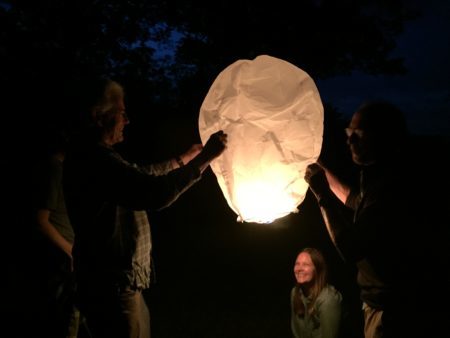 Daily, we are aware of just how much abundance our own ordinary life has offered of late. Daily, I am grateful. And, too, I’m aware of a darker current running beneath each day’s doings — a sadness and uncertainty that permeates even the simplest pleasure.
Daily, we are aware of just how much abundance our own ordinary life has offered of late. Daily, I am grateful. And, too, I’m aware of a darker current running beneath each day’s doings — a sadness and uncertainty that permeates even the simplest pleasure.
The other morning, watching return to their devastated home, while sipping coffee in the comfort of my own safe kitchen, I struggled to make sense of the scale of the catastrophe in Texas – a catastrophe already supplanted by an even greater one bearing down on Florida as I type these words.
For those of us far from harm’s way, the scope of the dangers, the suffering, and the destruction are unfathomable. All day I’ve been trying to imagine it. What is it like to see your very world destroyed before your eyes? I can watch TV and donate money for the victims and pray for the first responders. But these small gestures are nothing in the face of all that’s happened, all that will happen, and all that needs to happen in order to set our battered world back on course.
Trying to prepare people for the worst before Hurricane Harvey hit land, the National Weather Service predicted that storm would be “beyond anything ever experienced.” Last night, talking to my sister-in-law on the phone in Florida, I heard the fear in her voice as she, alone in her house – far from the coastline, but in the path of Irma nonetheless — made her own preparations for living through yet another storm “beyond anything experienced.” Later, watching the newscasters grope for words that might convey the scope and potential dangers of the latest hurricane, the word “unprecedented” was used for the second week in a row. Suddenly, it seems, “unprecedented” is happening with shocking regularity. And none of us, really, has any idea what to do.
Fifty inches of rain fall. Chemical plants explode. Nuclear power stations are shut down. Every school in the state of Florida closes. Power is lost. Entire islands are rendered uninhabitable. Wild fires rage out west. An earthquake leaves dozens dead in Mexico. Countless homes and businesses are destroyed. Gas runs out, as does water, lumber, canned food, and time. Meanwhile, more storms gather strength off shore.
Our weather has become cataclysmic, just as the scientists studying climate change have been predicting for years. It is one thing to hear those warnings. It is another to watch tragedy after tragedy unfold on the TV screen, scenes of animals and people fighting for their lives, immigrants forced to choose between drowning and deportation, thousands of homeless human beings wading through water and sifting through wreckage. And it is quite another thing altogether to actually live through any of this, to experience it directly. Honestly, I can hardly begin to comprehend it. At the same time, as a citizen of this country, I know that I must try.
Sitting here on a perfectly beautiful summer afternoon, it occurs to me that the rumor of sadness and change E.B. White evoked so many years ago is in fact a much larger truth today, an ending not only to a summer season but also to a kind of innocence none of us can any longer afford to indulge. On the surface, here, now, my own life has not changed. But in our country, in our world, on the planet, there are indeed profound shifts underway. We can continue to allow politics to divide us, to allow poisonous rhetoric to substitute for scientific fact, intellectual honesty, and informed problem-solving — but we do so at our peril.
Lately I’ve been thinking more and more that the whole idea of “sides” in any urgently needed conversation is both morally wrong and willfully dangerous. Deep down, don’t we all know this? When it comes to our planet, not to mention our survival as a species, there are no sides. There are only human beings, human beings who must honor our interconnectedness with all of life, and who must find common ground and deep compassion for the earth and for one another if we are to save ourselves. History is not something that just happens to us. It is also made by us — shaped by the choices we make, the stands we do or do not take, the knowledge we do or do not heed, the words we do or do not say, the painful truths we do or do not accept, the values we do or do not uphold.
Perhaps what we need at this moment is to put our well-defended labels and prejudices aside. They have not served us anyway. No one benefits from the acrimony that divides Democrats from Republicans, left from right, liberals from conservatives. I wonder what would happen if, instead of raising angry voices against each other, we were to join forces and begin to demand that our leaders, all of them, do what is right for our country, for our planet, for the animals and plants, and for each other.
There was not much good news to be found in the paper this week, but I’m heartened by an op-ed in the New York Times by Christina Todd Whitman. A Republican, the former governor of New Jersey and head of the EPA under George Bush, Whitman is, by her own admission, “not a part of the liberal resistance to the new administration.” But she is a moral, thoughtful person with a healthy respect for facts. And, as such, she finds herself very much at odds with Donald Trump and his choice of Scott Pruitt to run the E.P.A.
“The E.P.A is too important to treat like a reality TV show,” she writes. “People’s lives and our country’s resources are at stake.” Exactly so.
What would happen if each of us began speaking out for what we know to be true: our planet is in peril and we must work cooperatively to save it. Together, we can replace partisan politics and point-scoring with courageous, creative problem solving. We can do the hard thing, instead of the expedient, pocket-lining, short-sighted party thing.
Huge swaths of America, not to mention our island neighbors, are battered and bruised today. At this moment, millions are homeless, while millions more are evacuating or hunkered down awaiting imminent destruction. While Irma heads for land, the Caribbean is on watch for Jose, the third major hurricane in as many weeks. In Mexico, the earthquake death toll rises. And yet, amid the devastation, there are also reasons to hope.
It is in these moments of natural disaster that we show up not as partisans but as people, each of us committed to help in whatever way we can. I was struck by the story of one young Mexican “dreamer”, a 31-year-old immigrant who would have been deported under Trump’s plan to end DACA. He traveled 120 miles from his home to offer help to the people of Houston, only to lose his life trying to rescue stranded residents in a flooded apartment complex. A reminder to the rest of us: there are no sides.
From coast to coast, we are opening our wallets, writing checks, sending truckloads of hay and dog food, clothing and diapers and groceries. Perhaps, too, we are finally ready to face the inconvenient truth: Life as we have taken it for granted on this earth is already over. In the months to come, as tough decisions are made about what is sustainable now, something new will take its place. Whether that new way of inhabiting our world will contribute to the healing of our planet or degrade it even further is up to us. But if we are to choose the healing path then we must also be willing to travel that road as one people. And we must do so by placing a higher value on the health of the earth as a whole than we currently place on American power, political party, wealth, or expedience.
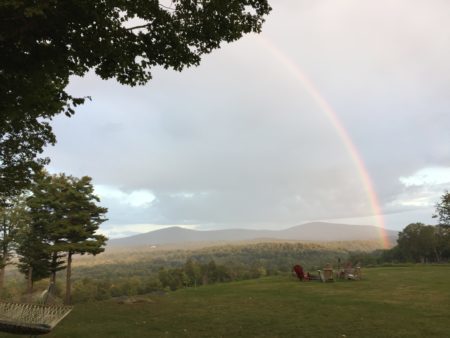 As I’ve been sitting here this afternoon, the day has changed, from balmy sunshine to cool and dark. Storm clouds have rolled in over the mountains and a sudden shower is bringing a brief, welcome rain to the garden. At this moment, there is a rainbow arcing across the sky. And so, looking out at this landscape I love so deeply, I find myself circling back to gratitude for what is, gratitude that is, as always now, inextricably intertwined with concern for what also is. We live in anxious times.
As I’ve been sitting here this afternoon, the day has changed, from balmy sunshine to cool and dark. Storm clouds have rolled in over the mountains and a sudden shower is bringing a brief, welcome rain to the garden. At this moment, there is a rainbow arcing across the sky. And so, looking out at this landscape I love so deeply, I find myself circling back to gratitude for what is, gratitude that is, as always now, inextricably intertwined with concern for what also is. We live in anxious times.
Let us not give in to or turn away from this anxiety, but transform it into hope. Let us engage with open minds and hearts in the hardest of conversations. Let’s read the writers and scientists who challenge our thinking. Let’s learn more and more, step out of our preconceptions and judgments, and then show up and find a way to make a difference. And, at the same time, let us remain awake to the small beauties and astonishments of our own ordinary days. Our survival depends on this — a sense of wonder, a profound respect for the fragility of all that we cherish and, too, an unwavering awareness that we’re in this together. It’s time to listen closely to the crickets’ song, to heed their insistent rumors of sadness and change. They are singing, after all, to you and me. As poet David Whyte has written, “Your great mistake is to act the drama as if you were alone.”
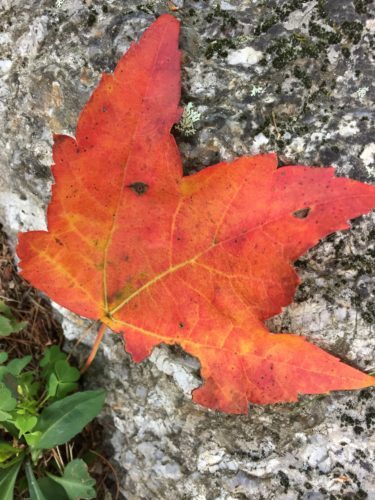
good works
If you are wondering where your donations to hurricane relief will do the most good, consider supporting the efforts of Team Rubicon, a dedicated group of veterans who are skilled in first response and highly organized. My yoga teacher worked closely with them in New York after Hurricane Sandy and recommends them highly. You can learn more here.
There are already politicians from both parties in Washington who are more committed to solving problems than to scoring wins. Cooperation doesn’t make headlines, but it can make headway. A reader introduced me to the group No Labels. Check them out here.
On Sunday, Sept. 24, I will join Team Diane (and thousands of others!) to walk 26.2 miles to raise money for ovarian cancer research. Seven years after my dear friend died at 55, I remain committed to this cause, in part because I know that every dollar we contribute goes directly to her doctor’s cutting-edge team of researchers at Dana Farber. If you would like to know more, visit my page here. We are all digging deep these days. That said, I am enormously grateful for your support — both in dollars and in good vibes as I try to get in shape to go the distance. (To those of you have already made donations, thank you. Handwritten letter to follow!)
SaveSave
SaveSave
SaveSave
SaveSave
SaveSave
SaveSave
The post no sides appeared first on Katrina Kenison.
August 23, 2017
making a difference, one step at a time
“Activism is the rent I pay for living on the planet.” ~ Alice Walker
These days, many of us are profoundly aware that the rent is going up. And, out of our deep love for our lives, our world, and each other, we respond in countless ways — with our voices, our dollars, our time, our conversations, even our bodies, as we dig deep and work together to make things better for all.
As every long-time reader here knows, one constant for me over the last seven years has been an annual commitment to help improve the odds for women diagnosed with cancer.
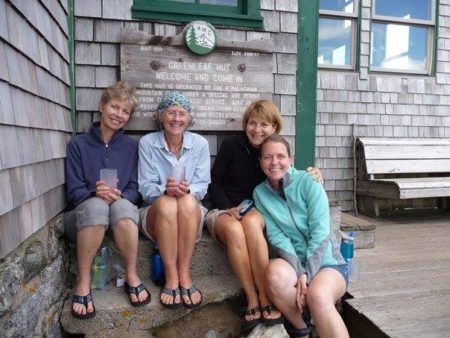 It has been seven years since my dear friend Diane died at age 55, after a four-year battle with ovarian cancer. I think often of all she’s missed — a daughter’s marriage, a son’s graduation from business school, seven Christmases, seven family vacations in Maine, the list is endless.
It has been seven years since my dear friend Diane died at age 55, after a four-year battle with ovarian cancer. I think often of all she’s missed — a daughter’s marriage, a son’s graduation from business school, seven Christmases, seven family vacations in Maine, the list is endless.
But I also recall the powerful ways in which her courage and grace continue to inspire those who knew her to be braver and more generous ourselves, and to do our part to make a difference in the lives of others, one step at a time.
Raising money and walking the Jimmy Fund Marathon route with Team Diane is my way of upholding the legacy of my own dear friend who died way too young. But it’s also a way to ensure that we — those of us who walk, and every single person who donates to this cause — are making the odds better for each of the 22,000 women who will be diagnosed with ovarian cancer this year.
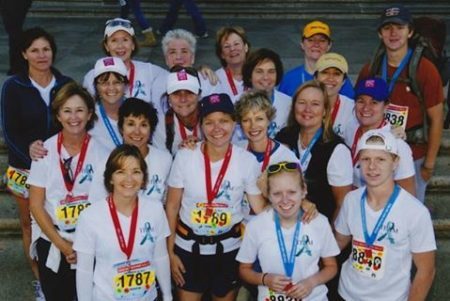 A month from tomorrow, I’ll be out there, walking 26.2 miles to raise funds for Dr. Ursula Matulonis’s cutting-edge team of researchers at Dana Farber. Dr. Matulonis was Diane’s doctor and, in the years since, she has become both a friend to our group and an inspiration to all of us who continue to support her work with the funds we raise. Thanks to the clarity of Diane’s final wishes, every dollar donated goes directly to Dr. Matulonis. In the last seven years, much progress has been made.
A month from tomorrow, I’ll be out there, walking 26.2 miles to raise funds for Dr. Ursula Matulonis’s cutting-edge team of researchers at Dana Farber. Dr. Matulonis was Diane’s doctor and, in the years since, she has become both a friend to our group and an inspiration to all of us who continue to support her work with the funds we raise. Thanks to the clarity of Diane’s final wishes, every dollar donated goes directly to Dr. Matulonis. In the last seven years, much progress has been made.
This year, I’m especially looking forward to Sept. 24 because Team Diane will welcome Diane’s older daughter and her new husband to our ranks. Also, my own “soul” daughter Lauren will fly up from Atlanta to walk with us.
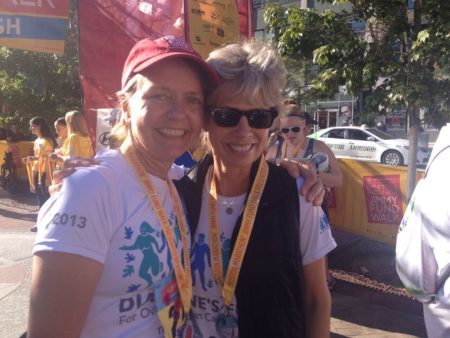 Our team began with loved ones, but the circle has grown to include many who didn’t know Diane but who have been touched by her story or by cancer in their own lives. This cause, and our annual contributions, have far exceeded anything we could have imagined when we first set out to support a fund in our friend’s memory. I’m pretty sure she would be delighted to know how far the ripples have reached.
Our team began with loved ones, but the circle has grown to include many who didn’t know Diane but who have been touched by her story or by cancer in their own lives. This cause, and our annual contributions, have far exceeded anything we could have imagined when we first set out to support a fund in our friend’s memory. I’m pretty sure she would be delighted to know how far the ripples have reached.
Many of us feel stretched thin right now, as we look for ways to promote healing in our world. That said, I’d be enormously grateful for your support, in any amount. And please know, I will be thinking of you and your loved ones as I walk on September 24.
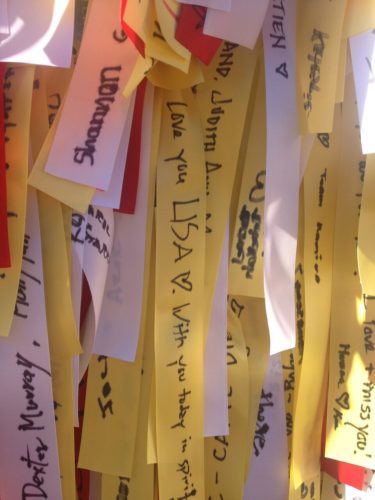 (One thing I’ve learned over these last months? Paying rent actually feels pretty good – much better than the alternative!)
(One thing I’ve learned over these last months? Paying rent actually feels pretty good – much better than the alternative!)
Click here to learn more and to support my walk: http://www.jimmyfundwalk.org/2017/KatrinaDiane
Gratefully,
Katrina
Support my walk, leave a comment, and you’ll be entered in a drawing to win two books.
It’s become something of a tradition for me to take this opportunity to give away a book or two, just to say an additional “thanks” to you — for reading, for being here, and for all you do.
If you choose to donate, be sure to leave a comment below. I’ll enter your name to win a copy of Mary Oliver’s “A Thousand Mornings” (because Diane and I shared a love of Mary Oliver’s poetry) and a signed copy of my own “Moments of Seeing” (because some of our long friendship is captured in those pages, and well, just because).
And if you want to meet Diane and see our team in action, take a few moments to watch this video Lauren created for us. It’s a great reminder of exactly why we do what we do!
Donating is one-click easy, here. And I’ll choose a book winner at random on Sept. 25. Needless to say, my heartfelt thank you’s will come to each and every one of you.
SaveSave
SaveSave
SaveSave
SaveSave
SaveSave
The post making a difference,
one step at a time appeared first on Katrina Kenison.
August 10, 2017
honor system
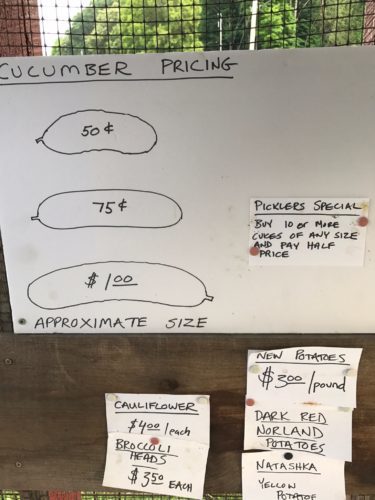 Acouple of weeks ago a friend texted me a photo from his local farmstand, where freshly picked cucumbers are priced according to length. Customers choose their produce, tally up what they owe, and leave their payments in a box. The farmer’s innocently suggestive drawing made me laugh.
Acouple of weeks ago a friend texted me a photo from his local farmstand, where freshly picked cucumbers are priced according to length. Customers choose their produce, tally up what they owe, and leave their payments in a box. The farmer’s innocently suggestive drawing made me laugh.
But what really struck me about the photo was the nostalgic beauty of this age-old endeavor – a way of doing business which simply assumes the best in each of us. During a summer in which the Boy Scouts have apologized for the behavior of the President of the United States and PolitiFact rates just 20% of his statements as true and 69% as either outright lies or false, it’s hard not to feel sad and suspicious of our moral culture, no matter where you fall on the political spectrum. As a nation, we are watching the criminal investigations into this administration unfold with a mixture of horror and fascination. Often times, as yet another presidential lie is exposed and supplanted by an actual fact, I wonder how this man goes to sleep at night. And what of those individuals who repeat his falsehoods in exchange for a paycheck? How do you live with yourself if you know most of the words that come out of your mouth are untrue and the things you do each day are dishonest?
When my son Jack was very young, his favorite story was Pinocchio. Although we didn’t watch many movies in our household, we did own the Disney version of Pinocchio and Jack watched it with endless fascination, as if that movie held for him the key to life. In a way, I think it did. There was Pinocchio, pulled again and again toward adventure and excitement and trouble, and tempted again and again to lie his way out of every jam. And there was Jiminy Cricket, whispering in his ear, “Go ahead, make a fool of yourself, then maybe you’ll listen to your conscience.”
What child really wants to hear “the still, small voice” that, as Jiminy himself acknowledges, “most people won’t listen to”? Growing up, we learn integrity the hard way, by trial and error – cheating on a test, shoplifting a pack of gum, throwing trash out the car window, lifting a few dollars from a parent’s dresser, telling a lie. Whether we get caught or not isn’t the issue. What matters is how we respond to that sense of hollow regret and self-loathing that comes with doing wrong. We can numb it, ignore it, and pursue a self-interested, self-aggrandizing path. Or we can heed the voice of our own inner authority and begin to choose the high road — every time, even if it’s hard.
It is only by strengthening our moral muscles that we grow up, grow wise, and become trustworthy. Maturity and integrity go hand in hand. But we are human, and fallible, and the process is ongoing. As Indian guru and philanthropist Sri Sathya Sai Baba observed, “Who you are is made up of three persons. There is the one you think you are, the one others think you are, and the one you really are. Work towards making all three the same. Then there will be peace and bliss.”
Fortunately, life offers us countless opportunities to practice spiritual alignment.
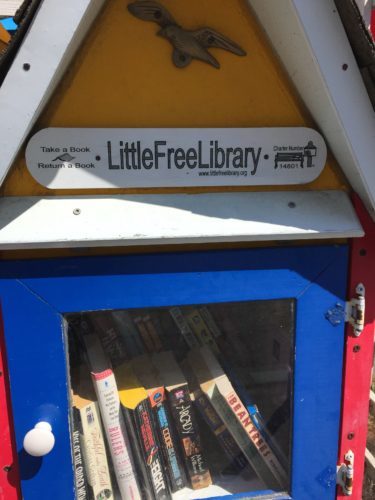 Over the last couple of weeks, I’ve countered some of the disillusion I feel in our government by keeping my eye out for old-style examples of the honor system. The truth is, we humans are healthier and happier when we do the right thing, even when no one is watching. It is lovely to be trusted. And it feels even better when we uphold that trust. A local farm stand or a roadside table offering flowers is an opportunity to participate in a two-way flow of faith in our own best selves.
Over the last couple of weeks, I’ve countered some of the disillusion I feel in our government by keeping my eye out for old-style examples of the honor system. The truth is, we humans are healthier and happier when we do the right thing, even when no one is watching. It is lovely to be trusted. And it feels even better when we uphold that trust. A local farm stand or a roadside table offering flowers is an opportunity to participate in a two-way flow of faith in our own best selves.
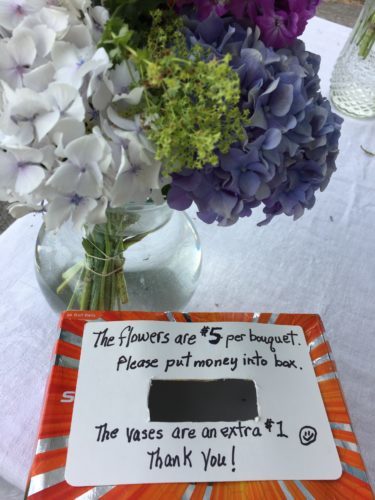 There is more than enough cause for despair in our nation this summer. I cannot change the President’s ways. But I can commit to raising the bar even higher in my own daily life, and to finding small ways to both do good and to be good. I can choose to pay forward kindness and honesty, whether it’s by picking up beer cans alongside the road, donating a special book for some passerby to discover, or placing more money than I owe in an unattended box.
There is more than enough cause for despair in our nation this summer. I cannot change the President’s ways. But I can commit to raising the bar even higher in my own daily life, and to finding small ways to both do good and to be good. I can choose to pay forward kindness and honesty, whether it’s by picking up beer cans alongside the road, donating a special book for some passerby to discover, or placing more money than I owe in an unattended box.
Here are a few more photos from my summer travels. Collecting them has been fun, and participating in these friendly exchanges always lifts my spirits.
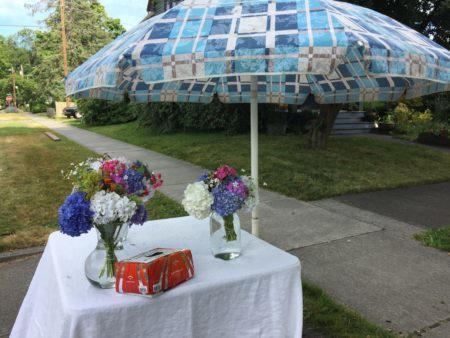 This charming table was set up on the sidewalk in the midst of a busy urban neighborhood. I loved that even the vases were for sale — for a buck!
This charming table was set up on the sidewalk in the midst of a busy urban neighborhood. I loved that even the vases were for sale — for a buck!
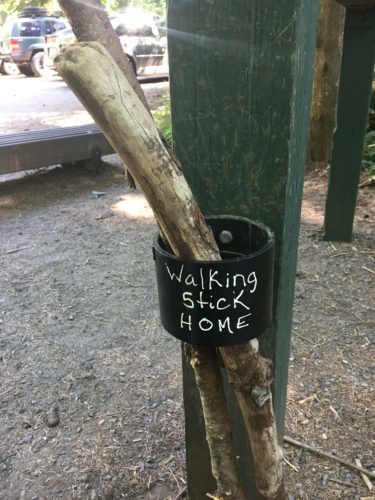 What a good idea, to leave behind a sturdy walking stick for the next hiker to use.
What a good idea, to leave behind a sturdy walking stick for the next hiker to use.
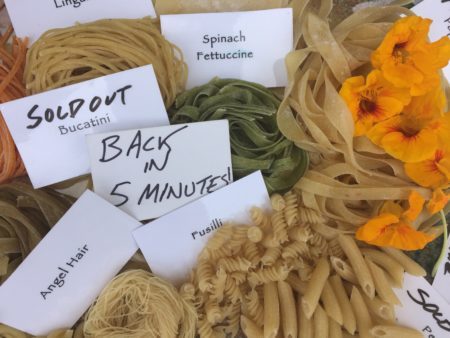 At the farmer’s market, the fresh pasta purveyor trusted her customers to wait for her return, or to leave their money if they were in a hurry.
At the farmer’s market, the fresh pasta purveyor trusted her customers to wait for her return, or to leave their money if they were in a hurry.
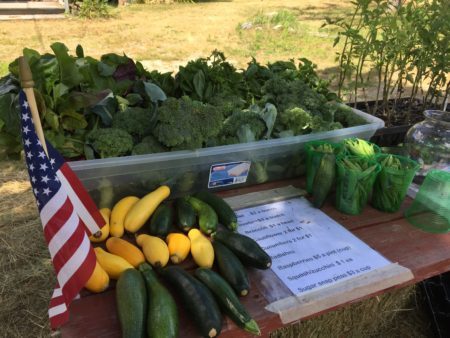 We walked past this neighbor’s table in Maine a few times last weekend. Each day the produce was restocked, beautifully.
We walked past this neighbor’s table in Maine a few times last weekend. Each day the produce was restocked, beautifully.
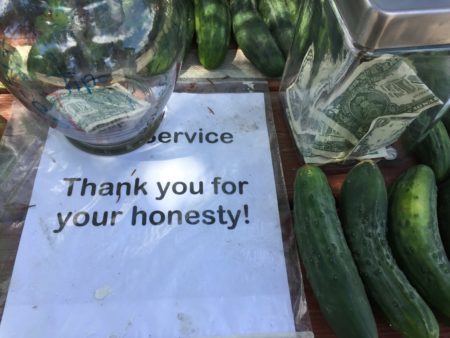 An honor jar is a point of pride, for both farmer and customer. And trust is a strong motivator, especially when the offerings are so generous.
An honor jar is a point of pride, for both farmer and customer. And trust is a strong motivator, especially when the offerings are so generous.
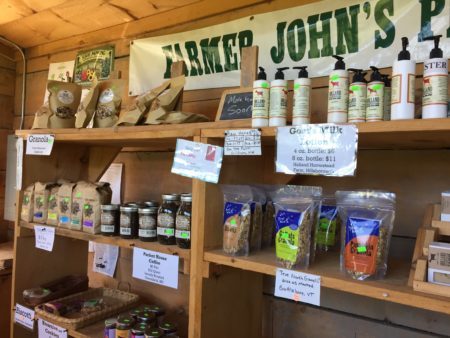 Here’s the set up at my own local self-service farmstand. There’s only one Farmer John, and he’s busy in the garden, so he trusts his customers to shop in his small store, record their purchases in a notebook, and leave their cash in the box. There’s a big basket full of spare change, a fridge full of berries and cheeses, organic lotions and potions, and home-baked pies made with love.
Here’s the set up at my own local self-service farmstand. There’s only one Farmer John, and he’s busy in the garden, so he trusts his customers to shop in his small store, record their purchases in a notebook, and leave their cash in the box. There’s a big basket full of spare change, a fridge full of berries and cheeses, organic lotions and potions, and home-baked pies made with love.
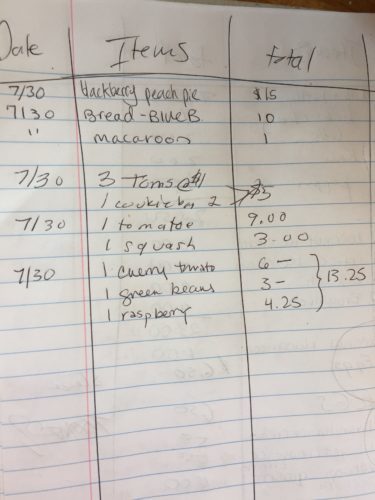 Although many local cooks and farmers bring their wares to sell at Farmer John’s, the place runs without a single employee. When the flag is at the door, the store is open for business.
Although many local cooks and farmers bring their wares to sell at Farmer John’s, the place runs without a single employee. When the flag is at the door, the store is open for business.
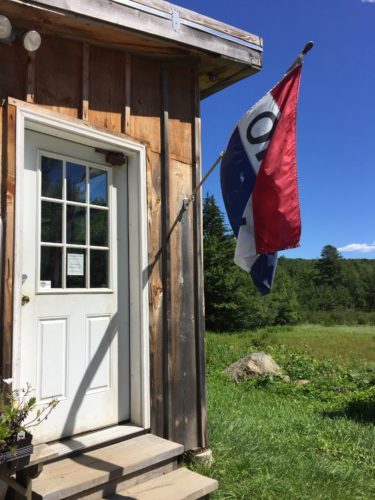
I’d love to hear about how the honor system is working in your neck of the woods. In the meantime, may we each do our small part to spread goodness, to support each other, to appreciate the simple pleasures, and to live with integrity and courage.
SaveSave
SaveSaveSaveSave
SaveSave
SaveSave
The post honor system appeared first on Katrina Kenison.
July 15, 2017
who is we?
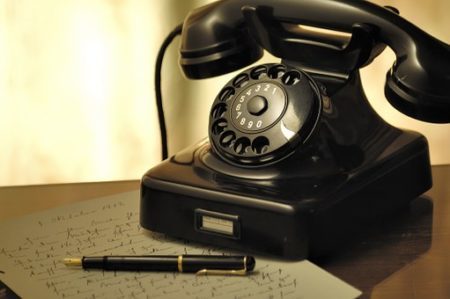 If you’ve ever fallen out of touch with a friend, you already know this: reconnecting isn’t easy. You quiet your nerves and deliberate for a moment before, finally, after months, picking up the phone just to say “hi.” You wait a beat or two before hitting send on an email with a header like, “Everything ok? I’ve missed you!” That’s sort of how it feels to me today, as I sit in my somewhat messy, decidedly lived-in kitchen and type these sentences onto the screen. I could clean up all the dishes from the veggie soup I’ve just made and rinse out the cans for recycling. Or I can let them wait, take a deep breath, put my fingers on the keys, and trust that words will come.
If you’ve ever fallen out of touch with a friend, you already know this: reconnecting isn’t easy. You quiet your nerves and deliberate for a moment before, finally, after months, picking up the phone just to say “hi.” You wait a beat or two before hitting send on an email with a header like, “Everything ok? I’ve missed you!” That’s sort of how it feels to me today, as I sit in my somewhat messy, decidedly lived-in kitchen and type these sentences onto the screen. I could clean up all the dishes from the veggie soup I’ve just made and rinse out the cans for recycling. Or I can let them wait, take a deep breath, put my fingers on the keys, and trust that words will come.
This morning I listened to an interview with writer Pico Iyer in which he explains why he spends the first hours of his day in silence. “I just sit there,” he says, “trying to sift through my projections, my distortions, trying to find the voice behind my chatter, trying to find, of all the things passing through my head, if there is any one thing worth committing to the page.”
Although I haven’t been doing much sitting lately – there are too many weeds in the garden to allow for that – I’ve been engaged in a similar kind of daily sorting and sifting and wondering. “Speak only if it improves upon the silence,” Ghandi advised, words I’ve considered while questioning my own writing, how to respond appropriately to the unfolding events in our world, and whether there’s any need to add one more voice to the clamor.
Reading the New York Times over breakfast, tuning in for the latest CNN breaking news updates as I peel potatoes in the evening, I’m at once pulled in and appalled. How to reconcile these small pleasures – the comfort of a morning cup of coffee, the routine of making a meal in my own familiar kitchen – with the deeply disturbing developments reported in the paper or on my TV screen?
More and more lately, I’m aware of a painful disconnect between the moral values we were all taught to uphold and the reality of the country we’ve created. How did this happen? We live in a nation where honesty, integrity, and morality are no longer seen as essential to leadership, or even, in this administration, as virtues. As a people we are deeply divided and mistrustful — of our elected officials, of the news media, of each other. How can we begin to reweave connections in a country in which people who disagree no longer respect differences of opinion but, rather, say they feel hatred for the other side?
How can we make sense of an increasingly complicated world when the U.S. president attacks the free press as his enemy and dismisses irrefutable facts and figures as fake news? How do we find our way forward as a nation when a simple click of the remote control leads one into a parallel universe offering a completely different spin on reality? How can we solve our most intractable problems when 58% of voters in one political party now believe that higher education has a damaging effect on America? How can we feel safe in a country in which the president, his family, and his advisors are inextricably entangled with a foreign adversary? How can we believe any statements from a leader or an administration whose lies are exposed daily and whose assertions and justifications for his actions change with the prevailing winds?
How can we hold our heads high in a country in which racial profiling has become normalized, even legal immigrants fear for their lives, and visitors to our shores are turned away because of how they look or where they’re from or how they worship? How can we effect sensible policy changes desired by a vast majority of Americans of both parties when scientific research is shut down and decades worth of objectively gathered data is made to disappear because it doesn’t serve a specific political agenda? How can we sleep at night in a country in which millions of people will lose their health care if the bill put forth this week is passed next week? What kind of country are we, if we are no longer committed to working with each other, and with the rest of the international community, to create peace, to protect human rights, and to save our fragile, rapidly warming planet?
My own list of unanswerable questions goes on and on. I suspect most of us are wrestling with these and similar ones as we absorb our daily doses of social media, headline news, serious analysis, and late-night humor. Grateful as I am to every investigative reporter working tirelessly to uncover what actually happened in the presidential election, I’m under no illusion that “the real story” is going to create any kind of meaningful change or healing for the country. We do need the truth. But we need much more than that.
I don’t want to be part of the problem – too cynical, or apathetic, or uninformed to engage in a serious discussion. But I haven’t been feeling much confidence lately in my ability to be part of the solution, either. What difference can any one person make? Sometimes, reading about North Korea’s latest missile test or an enormous iceberg breaking off Antarctica or a young Indian engineer shot to death in a Kansas bar simply because he was not white, I feel paralyzed.
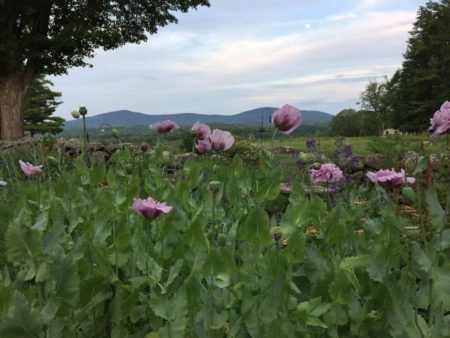 And so, day after day, as these lovely summer afternoons have passed, I’ve chosen silence over speech, walking or gardening or reading over writing. By nature, I step back from uncomfortable conversations. Let someone more knowledgeable and more thick-skinned than me pen the diatribe, the impassioned protest, the well-researched expose. Why provoke another family member to unfriend me on Facebook? At the same time, it feels almost capricious to write about what the birds are up to here, or what’s blooming in my garden, when the issues we must confront are so urgent and overwhelming. I love my own ordinary days as much as ever. But I’ve been a bit more hesitant about celebrating them and sharing them, in part because to do so seems, well, as if I’m turning a blind eye to all that is wrong in our world.
And so, day after day, as these lovely summer afternoons have passed, I’ve chosen silence over speech, walking or gardening or reading over writing. By nature, I step back from uncomfortable conversations. Let someone more knowledgeable and more thick-skinned than me pen the diatribe, the impassioned protest, the well-researched expose. Why provoke another family member to unfriend me on Facebook? At the same time, it feels almost capricious to write about what the birds are up to here, or what’s blooming in my garden, when the issues we must confront are so urgent and overwhelming. I love my own ordinary days as much as ever. But I’ve been a bit more hesitant about celebrating them and sharing them, in part because to do so seems, well, as if I’m turning a blind eye to all that is wrong in our world.
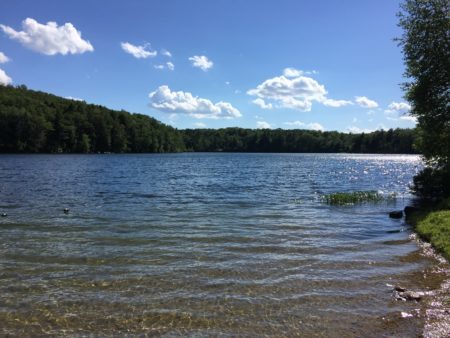 And yet, thankfully, life does go on. Children play and peas ripen on the vine and the water in the pond is perfect for swimming. Grown kids come home, friends arrive, fires are lit on our hilltop, and every moment feels like a blessing. Nature offers constant reminders of all that is beyond our own limited view and human understanding.
And yet, thankfully, life does go on. Children play and peas ripen on the vine and the water in the pond is perfect for swimming. Grown kids come home, friends arrive, fires are lit on our hilltop, and every moment feels like a blessing. Nature offers constant reminders of all that is beyond our own limited view and human understanding.
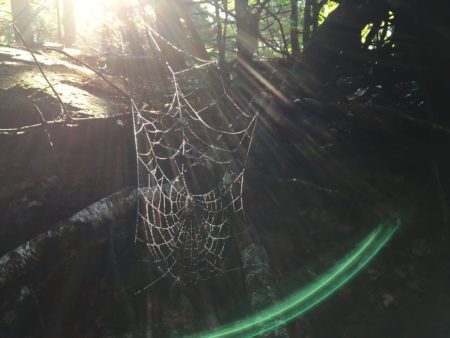 Somehow I want to find a way to be grateful for everything that is good and beautiful in this life and, at the same time, be courageous enough to speak up in defense of the ethics and ideals we’ve sacrificed on the altar of fear, disillusion, and suspicion. To write is to seek the truth behind one’s inner chatter and then to put it out there. It is to believe we can improve upon the silence. It is to have faith in the power of words to provoke us, connect us, and heal us. It is to have faith, period.
Somehow I want to find a way to be grateful for everything that is good and beautiful in this life and, at the same time, be courageous enough to speak up in defense of the ethics and ideals we’ve sacrificed on the altar of fear, disillusion, and suspicion. To write is to seek the truth behind one’s inner chatter and then to put it out there. It is to believe we can improve upon the silence. It is to have faith in the power of words to provoke us, connect us, and heal us. It is to have faith, period.
The other day, my friend Jena Schwartz quoted a line from Rebecca Solnit, written in response to a comment about climate change in which a reader had pointed out, “We have only ourselves to blame.”
“Who is we?” Solnit asked. “And what good is blame?”
Those two questions jolted through me like an electric current. We are we. And blame doesn’t ever soften a heart or open a mind.
Conversation does, though. So does curiosity coupled with education. So does kindness. And courage. Conversation creates connection, and if we are to survive as a democracy – not to mention as a planet — it will be because we remember that we are all connected. It will be because we’re curious enough about our differences to ask questions, and to believe in education’s power to transform fear and judgment into understanding, acceptance and cooperation. It will be because we place a higher value on decency than on victory, tax breaks, power, and revenge. It will be because more and more of us find our own ways to be brave. It will be because we continue to speak up, even when it’s uncomfortable to do so.
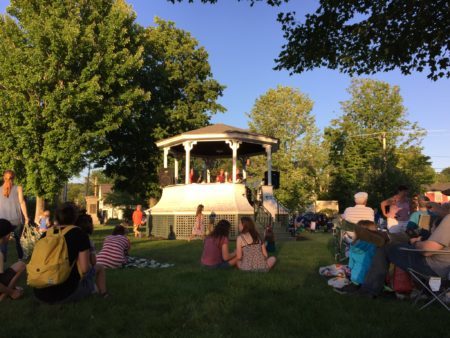 Who is we? Rebecca Solnit asks. I would like to believe that we are patriots. This, at least, is what I aspire to be: a patriot as defined by historian Timothy Snyder in his small, compelling book On Tyranny: Twenty Lessons from the Twentieth Century:
Who is we? Rebecca Solnit asks. I would like to believe that we are patriots. This, at least, is what I aspire to be: a patriot as defined by historian Timothy Snyder in his small, compelling book On Tyranny: Twenty Lessons from the Twentieth Century:
A patriot wants the country to live up to its ideals, which means asking us to be our best selves. A patriot must be concerned with the real world, which is the only place where her country can be loved and sustained. A patriot has universal values, standards by which she judges her nation, always wishing it well – and wishing that it would do better.
SaveSave
SaveSave
SaveSave
SaveSave
SaveSave
The post who is we? appeared first on Katrina Kenison.
April 17, 2017
to the mothers
Like the mother of the world, touch each being as your beloved child. ~ the Buddha
I’ve been thinking a lot lately about what it means to be a mother of grown children. My own two are in their twenties. The lives we all lead today – in three different parts of the country — are wildly different from the life we shared under one roof just a few short years ago.
And yet, although my duties have changed dramatically, I’m no less a mother today then I was then. In fact, most days I manage to find some opportunity to bring a bit of maternal energy into the world – perhaps on the other end of the phone with a son, or simply by watering a thirsty houseplant, offering a meal to someone who could use one, or sitting quietly with a friend.
Which makes me think: Aren’t we all mothers, whether or not we have biological children of our own? To be fully present for another is, in a spiritual sense, to be a mother.
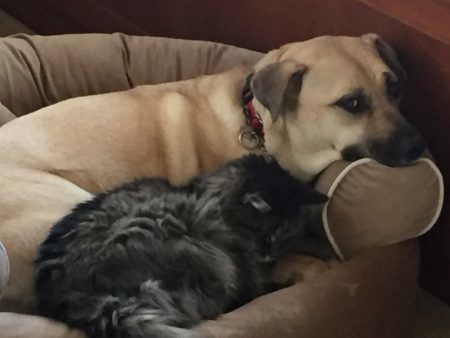 Each time we support the dignity, health, and growth of any living being, we are mothering the world within our reach. To be a mother is to nurture life. To be a mother is to love without condition or expectation. To be a mother is to recognize the divinity of all beings, everywhere. To be a mother is to honor the invisible and the intangible – kindness, humility, tenderness.
Each time we support the dignity, health, and growth of any living being, we are mothering the world within our reach. To be a mother is to nurture life. To be a mother is to love without condition or expectation. To be a mother is to recognize the divinity of all beings, everywhere. To be a mother is to honor the invisible and the intangible – kindness, humility, tenderness.
More than ever, our broken world is in need of mothers — mothers of all ages and shapes and sizes, mothers who are both life-giving and life-affirming, mothers who know in their bones what it is that we’re really here to do: Take care of each other and of our precious planet.
I made this video for all of us moms – and for the many beings we mother, human and otherwise. It’s my early Mother’s Day gift to you, in honor of all that you are and all that you do. I hope you enjoy watching it as much as I loved creating it. (Big thanks to my own spiritual daughter, Lauren Seabourne, for putting my words and images together so beautifully.)
And while we’re on the subject of mothers. . .
In honor of Mother’s Day, May 14, I’m offering personalized, signed, gift-wrapped copies of all of my books (some at special discounted rates — while supplies last). Details below. But don’t delay: deadline for all orders is Tuesday, May 2.
books!
signed, sealed, delivered, they’re yours
– in time for mother’s day
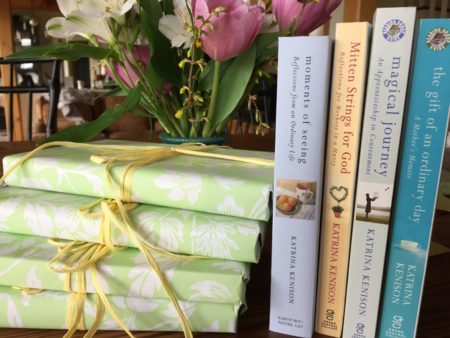
Want to order a signed book (or several) for the special moms in your life? It’s easy. Here’s how:
1. Click here.
(Note: This link will brings you to my own landing page on my husband’s website, Earth, Sky & Water. Steve sells beautiful posters, note cards, and laminated nature identification guides. And because his business is already all set up to take online orders and fulfill them quickly, he’s kindly offered to handle this special sale for me. While you’re there, feel free to browse his offerings, too.)
2. Want your book(s) personalized? Leave instructions for me in the “ORDER NOTES” FIELD on the shipping address page. Include the book title(s) you’ve ordered, the name for the inscription, and any special message you’d like me to write.
3. If there are no instructions, I’ll simply sign your book(s), gift-wrap them, and have them sent to the address specified.
4. For Mother’s Day only, I’m offering a reduced price that includes free gift-wrap by yours truly. Spend $80 or more and your shipping is free. (Use promotional code 4JOY on the shipping address page.)
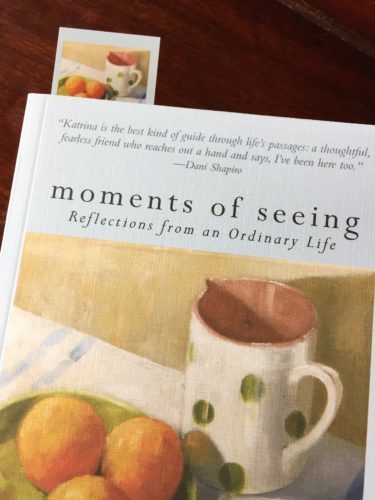
5. Every copy of my NEW book, Moments of Seeing, will include a bookmark featuring quotes from the book.
6. Hurry! Deadline for all orders is Tuesday, May 2.
The post to the mothers appeared first on Katrina Kenison.



